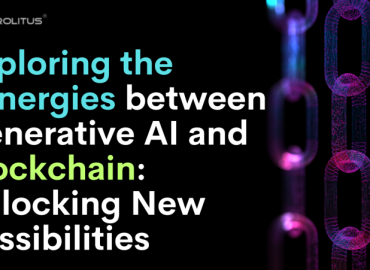Blockchain technology has revolutionized various industries with its secure, decentralized, and transparent nature. The NEAR Blockchain emerges as a robust player in this domain, designed with usability and scalability at its core. This beginner’s guide aims to navigate you through the essential realms of the NEAR Blockchain, unfolding its uniqueness and capabilities in the decentralized world. An exploration into its origin, architecture, usability, and various facets will equip you with a fundamental understanding, assisting in leveraging its functionalities for innovative applications and developments in the vast landscape of blockchain technology.
What is NEAR Blockchain?
NEAR Protocol, commonly known as NEAR blockchain, is a decentralized application platform designed to make apps usable on the web. The platform aims to enable developers to create decentralized applications with ease, focusing on scalability and usability. Originating as a public, sharded, developer-friendly blockchain, NEAR fosters innovation and the expansion of the decentralized web. Its unique design and architecture prioritize performance, simplifying the development process for creators and offering a seamless experience for end-users, making blockchain technology more accessible and practical for everyday use.
The architecture of NEAR Blockchain
The NEAR Protocol is ingeniously architectured to optimize scalability, usability, and resilience. Built on a sharded, proof-of-stake blockchain, NEAR ensures seamless execution of transactions and smart contracts. Shard chains, smaller chains that process their transactions and contracts, enhance scalability by parallelizing transaction processing. Each shard operates independently, improving the efficiency and speed of the overall network.
The consensus algorithm of NEAR, dubbed “Nightshade,” innovatively combines the benefits of both Proof of Stake (PoS) and sharding, ensuring network security and steady performance. Smart contracts on NEAR are flexible and user-friendly, allowing developers to deploy sophisticated decentralized applications (dApps) with ease. Storage in NEAR is managed efficiently, ensuring that data is handled in a secure yet accessible manner, enabling a robust and reliable infrastructure for decentralized solutions & applications.
How to Get Started with NEAR Blockchain
Getting started with the NEAR Blockchain involves a few fundamental steps that are essential for users who want to explore and participate in the NEAR ecosystem. Below, we’ll guide you through these initial steps to ensure you have a smooth beginning.
Setting up a Wallet
Choose a Wallet: Start by choosing a wallet that supports NEAR tokens. There are various options available, like NEAR Wallet, Ledger, and other multi-currency wallets.
Create an Account: Follow the wallet provider’s instructions to create an account. Usually, this involves setting up a username and a strong, secure password.
Secure Your Account: Ensure that your wallet is secure. Always enable two-factor authentication (2FA) and back up your recovery phrase in a safe place.
Acquiring NEAR Tokens
Choose an Exchange: To acquire NEAR tokens, choose a cryptocurrency exchange that lists NEAR. Some popular options include Binance, Coinbase, and Kraken.
Buy NEAR Tokens: Create an account on the chosen exchange, complete the necessary KYC processes, and you can start buying NEAR tokens by trading them against other cryptocurrencies or fiat.
Transfer to Your Wallet: Once purchased, it is advisable to transfer your NEAR tokens to your personal wallet. Ensure the address is correct, and the tokens will be securely stored in your wallet.
Exploring the NEAR Ecosystem
Join the Community: Become part of the NEAR community by joining forums, social media groups, or Discord channels. Engaging with the community can be a rich source of knowledge and support.
Explore DApps and Projects: Investigate various decentralized applications (DApps) and projects within the NEAR ecosystem. Familiarize yourself with their functionalities and how you can participate.
Stay Updated: Regularly check official NEAR blogs, and news websites, or subscribe to newsletters to stay updated with the latest developments, partnerships, and opportunities within the NEAR blockchain.
By completing these initial steps, you will have laid a solid foundation to effectively explore, understand, and participate in the diverse and dynamic ecosystem of the NEAR Blockchain. Happy exploring!
Staking on NEAR Blockchain
What is Staking?
Staking is a process that allows you to participate actively in the NEAR blockchain’s operations by locking up a certain amount of your NEAR tokens temporarily. This not only helps in securing the network but also rewards you for your contribution. Staking is crucial in proof-of-stake (PoS) and delegated proof-of-stake (DPoS) consensus mechanisms, where it aids in achieving consensus and validating transactions.
How to Stake NEAR Tokens
Choose a Validator: Look for validators or staking pools within the NEAR ecosystem that are reputable and trustworthy. These entities are responsible for validating transactions and creating new blocks in the blockchain.
Transfer NEAR Tokens: Once you have chosen a validator, you’ll need to transfer your NEAR tokens to the staking contract of the validator. Make sure you keep some tokens in your wallet to cover transaction fees.
Initiate the Staking Process: Follow the instructions provided by your chosen validator or staking pool. Usually, this involves going to the wallet interface, selecting the ‘Stake’ option, and following the prompts to complete the process.
Rewards and Risks
Rewards: By staking NEAR tokens, you can earn rewards in the form of additional tokens. The rewards are usually distributed proportionally based on the number of tokens you have staked. These rewards compensate for the tokens being locked up and for participating in the network’s security and consensus.
Risks: Staking also involves risks such as the fluctuation in the value of staked tokens and the possibility of slashing. Slashing occurs when a validator acts maliciously or fails to perform its role effectively, resulting in a loss of a portion of the staked tokens.
Unstaking: Keep in mind that unstaking usually involves a period where your tokens are ‘unbonded.’ During this time, your tokens are not accessible, and you won’t receive staking rewards.
Best Practices
Research: Before staking, thoroughly research the validators and ensure they are reliable and have a good performance history.
Diversify: Consider diversifying your stakes across multiple validators to mitigate risks associated with staking.
Stay Updated: Regularly check updates from NEAR and the validators to stay informed about any changes or updates in staking procedures and best practices.
By comprehending and carefully considering these aspects, beginners can make informed decisions and participate effectively in securing the NEAR blockchain while earning rewards for their contributions.
Use Cases and Applications of NEAR Blockchain
Decentralized Finance (DeFi)
- Facilitates the creation of decentralized financial applications such as lending platforms and decentralized exchanges.
- Enables seamless and secure transactions, fostering trust among users.
- Supports smart contracts, allowing the automation of complex financial operations without intermediaries.
Non-Fungible Tokens (NFTs)
- Promotes the minting, trading, and management of NFTs, supporting artists and creators.
- Enhances ownership and provenance tracking of unique digital assets like art, collectibles, and more.
- Offers a secure and efficient platform that ensures the uniqueness and authenticity of digital assets.
Gaming
- Provides a powerful platform for creating decentralized gaming applications.
- Enables the integration of NFTs into games, allowing gamers to have true ownership of in-game assets.
- Promotes fairness and transparency in gaming, enhancing user experience.
Supply Chain Management
- Supports the creation of decentralized supply chain solutions to enhance transparency and traceability.
- Facilitates real-time tracking of products and materials, improving operational efficiency.
- Reduces fraud and errors, ensuring that consumers receive genuine products.
Identity Verification
- Facilitates secure and efficient identity verification processes.
- Enhances user privacy by allowing individuals to have control over their personal information.
- Streamlines verification processes, making it easier for users to access various services.
Voting Systems
- Enables the development of secure and transparent voting systems for various purposes like governance and organizational decision-making.
- Reduces the risk of fraud and manipulation, enhancing the integrity of voting processes.
- Simplifies the voting process, making it more accessible to participants.
Smart Contracts and Legal Tech
- Allows for the creation of self-executing contracts that automatically enforce and execute the terms of an agreement.
- Improves the efficiency and reliability of legal processes.
- Reduces disputes and enhances trust among parties engaging in legal agreements.
Healthcare
- Supports the development of decentralized healthcare applications, improving patient data management.
- Enhances security and privacy, ensuring that sensitive healthcare information is well-protected.
- Facilitates seamless and secure sharing of healthcare data among authorized parties, improving patient care.
Each point elucidates the potential applications and benefits of utilizing the NEAR Blockchain in various sectors, showcasing its versatility and effectiveness in solving real-world problems and enhancing existing systems and processes.
Comparison with Other Blockchains
NEAR vs. Ethereum
- Scalability:
-
-
- NEAR employs sharding to handle more transactions, aiming to offer better scalability compared to Ethereum’s current capabilities.
-
- Consensus Mechanism:
-
-
- NEAR uses Nightshade, a PoS consensus mechanism, while Ethereum is transitioning from PoW to PoS (Ethereum 2.0).
-
- Smart Contracts:
-
-
- Both blockchains support smart contracts, but NEAR aims to make the development more accessible and user-friendly.
-
- Ecosystem and Community:
-
- Ethereum has a more established ecosystem. NEAR, while newer, is rapidly growing and fostering a strong community.
Polkadot vs. NEAR
- Interoperability:
-
-
- Polkadot emphasizes cross-chain interoperability. NEAR also supports interoperability but has a stronger focus on usability and simplicity.
-
- Sharding:
-
-
- Both networks utilize sharding, but their implementation and focus areas vary.
-
- Governance:
-
-
- Polkadot has a more complex governance model. NEAR’s governance is more streamlined and community-focused.
-
- Development Ease:
-
- NEAR tends to emphasize making blockchain accessible to developers, potentially making it easier to build on.
NEAR vs. Solana
- Performance:
-
-
- Solana is known for high performance and low fees, while NEAR also offers good performance with a focus on simplicity and developer experience.
-
- Consensus Mechanism:
-
-
- Solana uses Proof of History (PoH) in combination with PoS, while NEAR uses a PoS model with sharding.
-
- Developer Focus:
-
-
- NEAR is designed to be more user-friendly, lowering the entry barriers for developers.
-
- Market Position:
-
- While Solana has gained significant attention for its performance, NEAR focuses on a balanced approach, aiming for performance, simplicity, and a strong developer ecosystem.
Each point presents a concise comparison based on various critical aspects, providing readers with a clear perspective on how NEAR Blockchain positions itself against some of the major players in the blockchain industry.
Future Outlook and Trends
The NEAR Blockchain is poised at the cusp of innovation, with a robust pipeline of upcoming developments that aim to enhance scalability, usability, and functionality. Its adaptive sharding and developer-friendly environment herald a promising future, positioning it as a formidable contender in the decentralized technology landscape. Trend analyses forecast a sustained growth trajectory, although it must navigate challenges such as market saturation and evolving regulatory landscapes. Keep an eye on NEAR, as it cultivates a vibrant ecosystem, fosters partnerships, and spearheads groundbreaking solutions in decentralized finance, non-fungible tokens, and beyond.
Final Thoughts
In this guide, we navigated through the multifaceted landscape of the NEAR Blockchain. A strategic roadmap awaits those who seek to leverage the robust offerings of a NEAR Protocol Development Company. Embracing NEAR Blockchain Development Services unveils a spectrum of opportunities, from intuitive smart contracts to scalable decentralized applications. As you embark on your blockchain journey, let the transformative potential of the NEAR ecosystem be your beacon, guiding you towards innovative horizons and sustainable technological advancements. Dive deep, explore diligently, and unlock the remarkable potentials ingrained within the NEAR Blockchain.
Experience Excellence in NEAR Blockchain Solutions with Prolitus!
Experience unparalleled innovation with Prolitus, your gateway to cutting-edge NEAR Blockchain Solutions! Specializing in NEAR Protocol Development, Prolitus is poised to steer your projects toward groundbreaking success. Our dedication to excellence in NEAR Blockchain Development ensures that your blockchain aspirations are not just met, but exceedingly surpassed. Armed with a wealth of expertise and a futuristic approach, we are committed to delivering solutions that embody sophistication, functionality, and revolutionary prowess. Choose Prolitus, and immerse yourself in a realm where technology meets unmatched excellence in the cultivation of NEAR Blockchain potentials.





